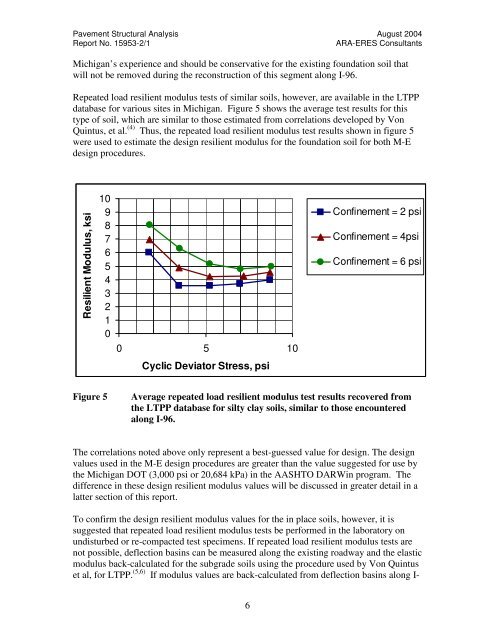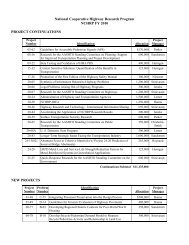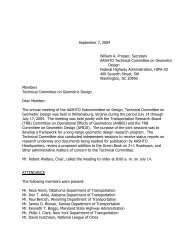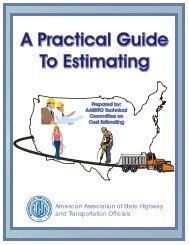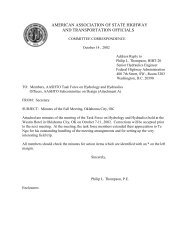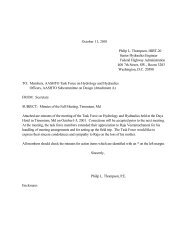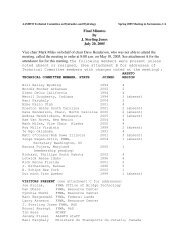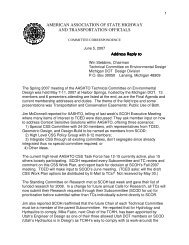Pavement Structural Analysis of the Design Recommendations for ...
Pavement Structural Analysis of the Design Recommendations for ...
Pavement Structural Analysis of the Design Recommendations for ...
Create successful ePaper yourself
Turn your PDF publications into a flip-book with our unique Google optimized e-Paper software.
<strong>Pavement</strong> <strong>Structural</strong> <strong>Analysis</strong> August 2004<br />
Report No. 15953-2/1 ARA-ERES Consultants<br />
Michigan’s experience and should be conservative <strong>for</strong> <strong>the</strong> existing foundation soil that<br />
will not be removed during <strong>the</strong> reconstruction <strong>of</strong> this segment along I-96.<br />
Repeated load resilient modulus tests <strong>of</strong> similar soils, however, are available in <strong>the</strong> LTPP<br />
database <strong>for</strong> various sites in Michigan. Figure 5 shows <strong>the</strong> average test results <strong>for</strong> this<br />
type <strong>of</strong> soil, which are similar to those estimated from correlations developed by Von<br />
Quintus, et al. (4) Thus, <strong>the</strong> repeated load resilient modulus test results shown in figure 5<br />
were used to estimate <strong>the</strong> design resilient modulus <strong>for</strong> <strong>the</strong> foundation soil <strong>for</strong> both M-E<br />
design procedures.<br />
Resilient Modulus, ksi<br />
10<br />
9<br />
8<br />
7<br />
6<br />
5<br />
4<br />
3<br />
2<br />
1<br />
0<br />
0 5 10<br />
Cyclic Deviator Stress, psi<br />
6<br />
Confinement = 2 psi<br />
Confinement = 4psi<br />
Confinement = 6 psi<br />
Figure 5 Average repeated load resilient modulus test results recovered from<br />
<strong>the</strong> LTPP database <strong>for</strong> silty clay soils, similar to those encountered<br />
along I-96.<br />
The correlations noted above only represent a best-guessed value <strong>for</strong> design. The design<br />
values used in <strong>the</strong> M-E design procedures are greater than <strong>the</strong> value suggested <strong>for</strong> use by<br />
<strong>the</strong> Michigan DOT (3,000 psi or 20,684 kPa) in <strong>the</strong> AASHTO DARWin program. The<br />
difference in <strong>the</strong>se design resilient modulus values will be discussed in greater detail in a<br />
latter section <strong>of</strong> this report.<br />
To confirm <strong>the</strong> design resilient modulus values <strong>for</strong> <strong>the</strong> in place soils, however, it is<br />
suggested that repeated load resilient modulus tests be per<strong>for</strong>med in <strong>the</strong> laboratory on<br />
undisturbed or re-compacted test specimens. If repeated load resilient modulus tests are<br />
not possible, deflection basins can be measured along <strong>the</strong> existing roadway and <strong>the</strong> elastic<br />
modulus back-calculated <strong>for</strong> <strong>the</strong> subgrade soils using <strong>the</strong> procedure used by Von Quintus<br />
et al, <strong>for</strong> LTPP. (5,6) If modulus values are back-calculated from deflection basins along I-


